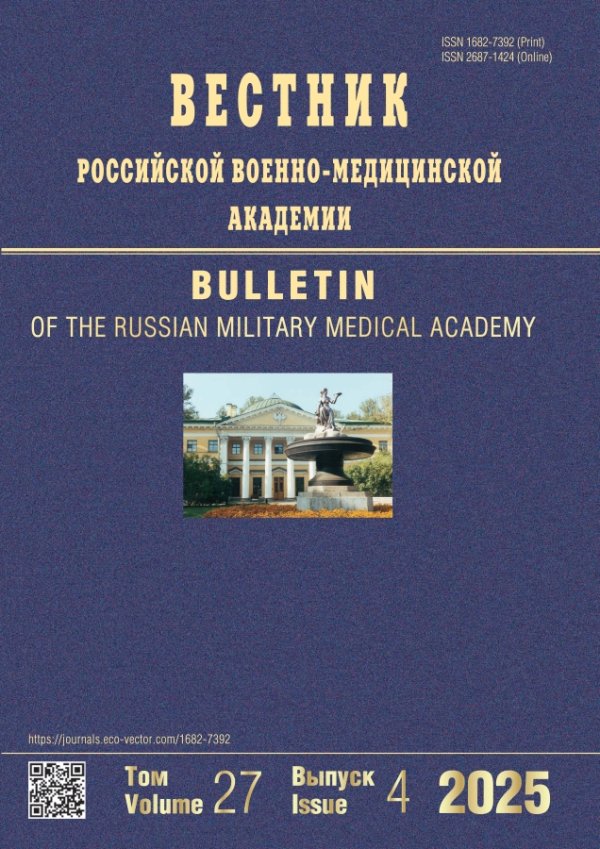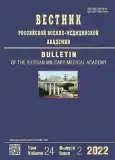Внепеченочные проявления хронического вирусного гепатита С
- Авторы: Крюков Е.В.1, Черкашин Д.В.1, Салухов В.В.1, Матюшенко К.В.1, Соболев А.Д.1, Щербина Н.Н.1
-
Учреждения:
- Военно-медицинская академия имени С.M. Кирова
- Выпуск: Том 24, № 2 (2022)
- Страницы: 341-352
- Раздел: Научные обзоры
- URL: https://journals.rcsi.science/1682-7392/article/view/103982
- DOI: https://doi.org/10.17816/brmma103982
- ID: 103982
Цитировать
Аннотация
Хронические вирусные заболевания печени характеризуются частыми клиническими признаками внепеченочных проявлений. Инфекцию, вызванную вирусом гепатита С, следует рассматривать как системное расстройство, связанное с частым развитием различных внепеченочных проявлений, таких как криоглобулинемия, гломерулопатии, лимфопролиферативные заболевания, серонегативный артрит, сахарный диабет 2-го типа, красный плоский лишай и поздняя кожная порфирия. Часто внепеченочные проявления становятся основными в клинической картине заболевания, вынуждая пациентов обращаться за медицинской помощью к разным специалистам и затягивая время диагностики заболевания. В ряде случаев лечение именно пациентов с внепеченочнми проявлениями становится самостоятельной сложной задачей, превосходящей собственно лечение хронического гепатита С. Взаимоотношение печеночных и внепеченочных проявлений вирусного гепатита С не является линейным и часто внепеченочные проявления опережают развитие поражения печени. Влияние вируса гепатита С на органы и системы организма обусловлено прямым воздействием вируса, патогенетически обусловленным развитием стеатоза/стеатогепатита, нарушением системной регуляции гепатокинов и цитокинов. Лечение хронической инфекции, вызванной вирусом гепатита С, должно быть комплексным и включать противовирусную терапию, терапию метаболически ассоциированной жировой болезни печени и терапию внепеченочных проявлений заболевания. Противовирусная терапия препаратами прямого действия позволяет предотвратить развитие не только «печеночных», но и многих «внепеченочных» осложнений вируса гепатита С. Коморбидные состояния существенно утяжеляют естественное течение хронической инфекции, вызванной вирусом гепатита С, равно как и, наоборот, вирус гепатита С усиливает клинические проявления сопутствующей патологии. В эпоху противовирусных препаратов прямого действия есть возможность элиминации вируса гепатита С, однако сама по себе элиминация в ряде случаев не останавливает процесс прогрессирования заболевания печени.
Полный текст
Открыть статью на сайте журналаОб авторах
Евгений Викторович Крюков
Военно-медицинская академия имени С.M. Кирова
Email: evgeniy.md@mail.ru
ORCID iD: 0000-0002-8396-1936
SPIN-код: 3900-3441
Scopus Author ID: 57208311867
ResearcherId: AAO-9491-2020
доктор медицинских наук, профессор
Россия, Санкт-ПетербургДмитрий Викторович Черкашин
Военно-медицинская академия имени С.M. Кирова
Email: cherkashin_dmitr@mail.ru
ORCID iD: 0000-0003-1363-6860
SPIN-код: 2781-9507
доктор медицинских наук, профессор
Россия, Санкт-ПетербургВладимир Владимирович Салухов
Военно-медицинская академия имени С.M. Кирова
Email: vlasaluk@yandex.ru
ORCID iD: 0000-0003-1851-0941
SPIN-код: 4531-6011
доктор медицинских наук, профессор
Россия, Санкт-ПетербургКонстантин Витальевич Матюшенко
Военно-медицинская академия имени С.M. Кирова
Email: kvmat@mail.ru
ORCID iD: 0000-0002-7399-3694
SPIN-код: 8656-9671
кандидат медицинских наук
Россия, Санкт-ПетербургАлексей Дмитриевич Соболев
Военно-медицинская академия имени С.M. Кирова
Автор, ответственный за переписку.
Email: sobolevvmeda@rambler.ru
ORCID iD: 0000-0003-1908-7954
SPIN-код: 3831-6584
преподаватель
Россия, Санкт-ПетербургНиколай Николаевич Щербина
Военно-медицинская академия имени С.M. Кирова
Email: n.shcherbina@list.ru
ORCID iD: 0000-0003-4550-1514
кандидат медицинских наук
Россия, Санкт-ПетербургСписок литературы
- Hanafiah K.M., Groeger J., Flaxman A.D., Wiersma S.T. Global epidemiology of hepatitis C virus infection: new estimates of age-specific antibody to HCV seroprevalence // Hepatology. 2013. Vol. 57, No. 4. P. 1333–1342. doi: 10.1002/hep.26141
- Cacoub P., Rosenthal E. Extrahepatic manifestations in chronic hepatitis C virus carriers // Lupus. 2015. Vol. 24, No. 4–5. P. 469–482. doi: 10.1177/0961203314556140
- Чернов В.С., Козлов К.В., Патлусов Е.П., Кузнецов П.Л. Хронический гепатит С: обзор современной литературы // Уральский медицинский журнал. 2019. № 9. С. 85–93. doi: 10.25694/URMJ.2019.09.16
- Жданов К.В., Яременко М.В., Козлов К.В., и др. Неинвазивная диагностика фиброза печени у больных хроническим гепатитом С и абдоминальным ожирением // Журнал инфектологии. 2020. Т. 12, № 1. С. 40–47. doi: 10.22625/2072-6732-2020-12-1-40-47
- Simmonds P., Bukh J., Combet C., et al. Consensus proposals for a unified system of nomenclature of hepatitis C virus genotypes // Hepatology. 2005. Vol. 42, No. 4. P. 962–973. doi: 10.1002/hep.20819
- Калинина О.В. Вирус гепатита С: механизмы изменчивости, классификация, эволюция // Вопросы вирусологии. 2015. Т. 60, № 5. С. 5–10.
- Galossi A., Guarisco R., Bellis L., et al. Extrahepatic manifestations of chronic HCV infection // J Gastrointestin Liver Dis. 2007. Vol. 16, No. 1. P. 65.
- Крюков Е.В., Поп В.П., Рукавицын О.А. Особенности гематологических нарушений у пациентов при хронической HCV-инфекции и подходы к лечению // Инфекционные болезни: новости, мнения, обучение. 2018. Т. 7, № 3. С. 95–101. doi: 10.24411/2305-3496-2018-13014
- Крюков Е.В., Поп В.П., Рукавицын О.А. Влияние вирусов гепатитов на лимфоидную ткань и современные возможности терапии вирус-ассоциированных лимфом // Инфекционные болезни: новости, мнения, обучение. 2017. № 6. С. 53–61. doi: 10.24411/2305-3496-2017-00005
- Jukić L.V., Kralj D. Extrahepatic Manifestations of Hepatitis C Virus Infection. In: Smolic M., Vcev A., Wu G.Y., editors. Update on Hepatitis C. London: IntechOpen, 2017. doi: 10.5772/intechopen.70728
- Ferri C., Sebastiani M., Giuggioli D., et al. Hepatitis C virus syndrome: A constellation of organ-and non-organ specific autoimmune disorders, B-cell non-Hodgkin’s lymphoma, and cancer // World J Hepatol. 2015. Vol. 7, No. 3. P. 327–343. doi: 10.4254/wjh.v7.i3.327
- Cacoub P., Desbois A.C., Isnard-Bagnis C., et al. Hepatitis C virus infection and chronic kidney disease: time for reappraisal // J Hepatol. 2016. Vol. 65, No. 1. P. S82–S94. doi: 10.1016/j.jhep.2016.06.011
- Kuna L., Jakab J., Smolic R., et al. HCV Extrahepatic Manifestations // J Clin Transl Hepatol. 2019. Vol. 7, No. 2. P. 172–182. doi: 10.14218/JCTH.2018.00049
- Maslennikov R., Ivashkin V., Efremova I., Shirokova E. Immune disorders and rheumatologic manifestations of viral hepatitis // World J Gastroenterol. 2021. Vol. 27, No. 18. P. 2073–2089. doi: 10.3748/wjg.v27.i18.2073
- Adinolfi L.E., Rinaldi L., Guerrera B., et al. NAFLD and NASH in HCV Infection: Prevalence and Significance in Hepatic and Extrahepatic Manifestations // Int J Mol Sci. 2016. Vol. 17, No. 6. P. 803. doi: 10.3390/ijms17060803
- Fouad Y., Waked I., Bollipo S., et al. What’s in a name? Renaming NAFLD to MAFLD // Liver International. 2020. Vol. 40, No. 6. P. 1254–1261. doi: 10.1111/liv.14478
- Eslam M., Sanyal A.J., George J. MAFLD: a consensus-driven proposed nomenclature for metabolic associated fatty liver disease // Gastroenterology. 2020. Vol. 158, No. 7. P. 1999–2014. doi: 10.1053/j.gastro.2019.11.312
- Perumpail B.J., Khan M.A., Yoo E.R., et al. Clinical epidemiology and disease burden of nonalcoholic fatty liver disease // World J Gastroenterol. 2017. Vol. 23, No. 47. P. 8263–8276. doi: 10.3748/wjg.v23.i47.8263
- Жданов К.В., Карякин С.С., Козлов К.В., и др. Хронический гепатит С и неалкогольная жировая болезнь печени. Основные аспекты патогенеза. Основные аспекты патогенеза // Вестник Российской военно-медицинской академии. 2018. № 1. С. 216–221. doi: 10.17816/brmma12326
- Wang F., So K.-F., Xiao J., Wang H. Organ-organ communication: The liver’s perspective // Theranostics. 2021. Vol. 11, No. 7. P. 3317–3330. doi: 10.7150/thno.55795
- Agnello V., Chung R.T., Kaplan L.M. A role for hepatitis C virus infection in type II cryoglobulinemia // N Engl J Med. 1992. Vol. 327. P. 1490–1495. doi: 10.1056/NEJM199211193272104
- Misiani R., Bellavita P., Fenili D., et al. Hepatitis C Virus Infection in Patients with Essential Mixed Cryoglobulinemia // Ann Intern Med. 1992. Vol. 117, No. 7. P. 573–577. doi: 10.7326/0003-4819-117-7-573
- Ferri C., Ramos-Casals M., Zignego A.L., et al. International diagnostic guidelines for patients with HCV-related extrahepatic manifestations. A multidisciplinary expert statement // Autoimmun Rev. 2016. Vol. 15, No. 12. P. 1145–1160. doi: 10.1016/j.autrev.2016.09.006
- Damoiseaux J. The diagnosis and classification of the cryoglobulinemic syndrome // Autoimmun Rev. 2014. Vol. 13, No. 4–5. P. 359–362. doi: 10.1016/j.autrev.2014.01.027
- Muchtar E., Magen H., Gertz M.A. How I treat cryoglobulinemia // Blood. 2017. Vol. 129, No. 3. P. 289–298. doi: 10.1182/blood-2016-09-719773
- Dammacco F., Sansonno D. Therapy for hepatitis C virus–related cryoglobulinemic vasculitis // N Engl J Med. 2013. Vol. 369. P. 1035–1045. doi: 10.1056/NEJMra1208642
- Perez S., Kaspi A., Domovitz T., et al. Hepatitis C virus leaves an epigenetic signature post cure of infection by direct-acting antivirals // PLoS Genetics. 2019. Vol. 15, No. 6. ID e1008181. doi: 10.1371/journal.pgen.1008181
- Adinolfi L.E., Zampino R., Restivo L., et al. Chronic hepatitis C virus infection and atherosclerosis: clinical impact and mechanisms // World J Gastroenterol. 2014. Vol. 20, No. 13. P. 3410. doi: 10.3748/wjg.v20.i13.3410
- Морозова Т.С. Клинико-патогенетические подходы к прогнозированию кардиоваскулярных осложнений у пациентов с хроническими вирусными заболеваниями печени: автореф. дис. … д-ра мед. наук. Екатеринбург, 2021. 50 с.
- Alavi M., Law M.G., Valerio H., et al. Declining hepatitis C virus-related liver disease burden in the direct-acting antiviral therapy era in New South Wales, Australia // J Hepatol. 2019. Т. 71, No. 2. P. 281–288. doi: 10.1016/j.jhep.2019.04.014
- Shengir M., Elgara M., Sebastiani G. Metabolic and cardiovascular complications after virological cure in hepatitis C: What awaits beyond // World J Gastroenterol. 2021. Vol. 27, No. 17. P. 1959–1972. doi: 10.3748/wjg.v27.i17.1959
- Manns M.P., Buti M., Gane E., et al. Hepatitis C virus infection // Nature Reviews Disease Primers. 2017. Vol. 3. ID 17006. doi: 10.1038/nrdp.2017.6
- Лазебник Л.Б., Голованова Е.В., Туркина С.В., и др. Неалкогольная жировая болезнь печени у взрослых: клиника, диагностика, лечение. Рекомендации для терапевтов, третья версия // Экспериментальная и клиническая гастроэнтерология. 2021. Т. 1, № 1. С. 4–52. doi: 10.31146/1682-8658-ecg-185-1-4-52
- Frosi A. Extrahepatic Manifestations of Hepatitis C Infection. In: Rodrigo L., Martins I., Guo X., Qi X., editors. Advances in Hepatology. London: IntechOpen, 2021. doi: 10.5772/intechopen.95995
- Жданов К.В., Козлов К.В., Сукачёв В.С., Жабров С.С. Реальная клиническая практика и ближайшие перспективы безинтерфероновой терапии пациентов с хроническим гепатитом С (генотип 1) // Инфекционные болезни. 2018. Т. 16, № 2. С. 98–103. doi: 10.20953/1729-9225-2018-2-98-10
Дополнительные файлы















